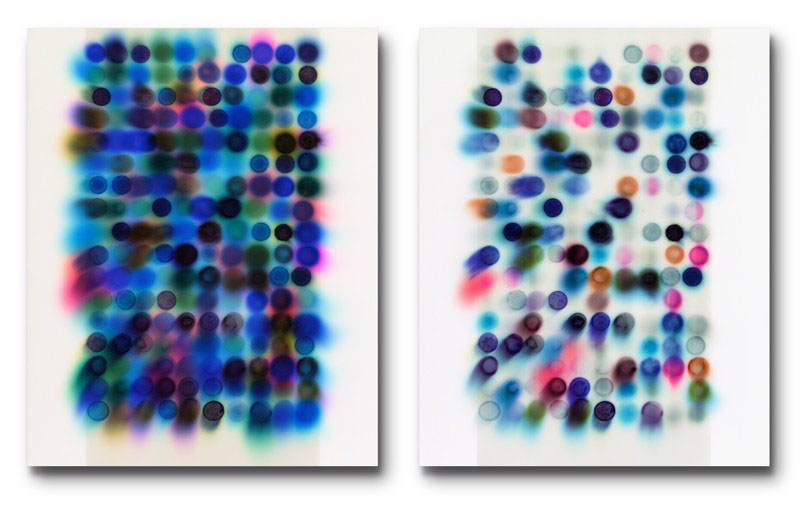By David M. Roth
Jaq Chartier has built an enviable career navigating the gulf between the temporal and the permanent. Employing scientific rigor and visual pleasure-seeking in roughly equal measure, the artist hit her stride in the late 1990s with a series called Testing — experiments, essentially, in which she measured the stability of water-soluble inks, dyes and stains. Those deemed archival wound up on wood panels as daubs, dashes, circles and fuzzy stains that resembled luminescent bacteria growing in petri dishes. Colors that exhibited too much volatility got shelved, along with all the pertinent research data.
Recently, the Seattle artist reversed course by revisiting the “fugitive” colors she previously set aside. She blended them with “light-fast/permanent” colors to create hybrid formulations which, when committed to panels and subjected to light, deteriorated at different speeds, producing hues she couldn’t anticipate. By scanning the results at intervals ranging from hours to months and digitally enlarging them well beyond their original notebook-sized dimensions, the artist creates lasting records of the precise changes each group of stains undergoes. The supersaturated (and sometimes very faded) results on view in Under the Sun, her current exhibition at Dolby Chadwick Gallery, rank among the most exciting retinal experiences this side of James Turrell.
Day 1 and Day 10 (Blues) | 2021 | time-based image capture, dye sublimation on aluminum | 50 x 50 inches
Overall, Chartier’s work resists, but never entirely defeats, the impulse to free associate. Nevertheless, the artist strives for – and mostly achieves — the constructivist goal of non-objectivity: an art free of real-world referents. In so doing, her works invite us to contemplate the core structure of color rather than, say, the relationships between colors as Joseph Albers’ paintings do. The process exhibits a unique dialectical character.
It begins with an overall chromatic impression registered by whatever colors dominate a particular grouping. Next come macro views where the eye leaps back and forth between early and late-stage images, charting not only color shifts but certain artifacts that become visible en route. The latter range from fiery penumbral rings to plaid columns to diffuse clouds – things that would not be visible had the artist not used a scanner to freeze and magnify the “action.” In Day 1 and Day 10 (Blues), for example, banana-shaped stains enlarged well beyond their original size show pigment shattering into discernible “islands.” Mostly what we experience, though, is the intensity of the colors. The strongest examples are SunTest #16, a retina-tingling display dominated by reds that, over 131 days, morph into both lighter and darker hues, and SunTest #10. In the latter, columns of blurry circles appear to be flying toward you at high speed — an effect I can only liken to a dolly zoom shot of a paintball fight.

SunTest #10 (Day 1 & 38) | 2020 | time-based image capture, dye sublimation on aluminum metal print | 20 x 34 inchesChartier explained she has no scientific training beyond what she learned working a freelance gig with Golden Artist Colors. There, she undertook an “in-depth study of acrylic archival painting practices” to give lecture demonstrations that translated a lot of technical information “into language artists could understand and put to practical use.” To illustrate, she created “mini paintings” that demonstrated the behavior of various paints. “I was endlessly curious about all the materials for my students as well as for myself and made lots of extra mini-tests to answer my own questions. At the same time, I was groping around in my studio, painting grid-based organic abstractions and gathering sciency images of stuff like DNA electrophoresis. At some point, all of these things merged in my mind and I started seeing the mini-tests as actual paintings. My mantra became: ‘The real painting is the one that isn’t a painting’ — which really opened things up.”

